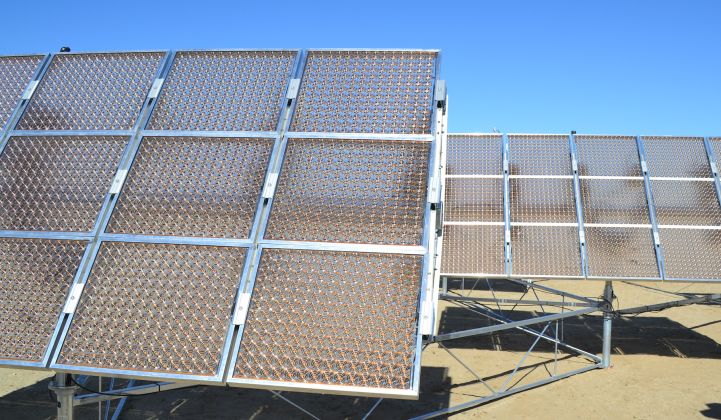Morgan Solar, a concentrating photovoltaic manufacturer based in Toronto, has partnered with pipeline giant Enbridge to build the largest solar project in Alberta, the fossil-fuel heartland of Canada.
The 10-megawatt project -- called Alberta Solar One -- will be located on about 60 acres in the sun-rich southeastern region of the province. It’s expected to consist of about 40,000 Morgan Solar panels, which use an optical design considered unique in a CPV industry that has struggled to stay competitive with conventional PV technology.
“Alberta is an exciting place for projects right now,” said Hugo Navarro, vice president of project development at nine-year-old Morgan Solar. The province, a heavy user of coal-fired electricity and home to Canada’s controversial oil sands, is going through a major energy transition. “They are the most gung-ho of any jurisdiction we’ve worked with,” he said.
The current government has committed to introducing a CAN $20 carbon tax at the start of next year, climbing to $30 in 2018, and has put a hard cap on emissions from the oil sands. It has also pledged to tap its solar and wind resources as part of an ambitious plan to phase out coal-fired power generation by 2030. Currently, coal represents more than half of Alberta’s power mix.
Alberta Solar One will be Morgan Solar’s first utility-scale project, and it has secured significant funding -- CAN $10 million, or 43 percent of total cost -- from the province’s Climate Change and Emissions Management Corporation, an investor in GHG-reduction initiatives.
The project is part of Morgan Solar’s efforts to boost its annual production capacity to 100 megawatts. Founder and president John Paul Morgan, who is also chief technology officer, said if manufacturing can be scaled to that level, modules can be produced for an estimated 30 cents a watt. “At that low cost basis, there’s a lot of room for setting a price that silicon PV can’t beat,” said Morgan, adding that at the gigawatt scale, production costs are projected to fall to the mid-teens.
Achieving that cost point will also mean upping module efficiency. Currently, the company’s CPV modules are about 30 percent efficient. “We’re expecting to be at about 40 percent by the end of 2017,” said Morgan. “Now, that’s a goal -- we’re not there yet. But we can see what we need to do to get there, and all of the pieces needed to achieve that exist today and are in place.”
The company’s technology doesn’t rely on a Fresnel lens or parabolic mirrors to concentrate sunlight. It instead uses a “light-guide solar optic” that bends incoming light at a near right angle and guides it to a high-efficiency PV chip (no larger than the tip of a ballpoint pen) using the principles of refraction and total internal reflection. It all takes place inside a thin wafer of acrylic and glass, meaning no need for boxy enclosures that add to system weight and material costs.
Like all CPV technologies, Morgan Solar’s modules must be on trackers to maintain high efficiency. The company has developed its own dual-axis tracker system, called Savanna, which it says is lower-cost than competing systems.
With trackers included, can Morgan come in at less than $1 per watt by 2017 -- beating First Solar? “We are quoting prices that will beat them at that price then, but this year our volumes are still too small,” Morgan said.
As GTM has previously reported, CPV vendors have collapsed due to falling silicon PV prices. Global manufacturing capacity took a major hit in 2015 after France’s Soitec abandoned its CPV efforts and sold its assets to a Chinese buyer. Meanwhile, China’s Suncore has shut down its own CPV manufacturing.
“With the largest manufacturers exiting CPV in 2015, the CPV industry is undergoing a severe crisis,” concluded a February 2016 report from the National Renewable Energy Laboratory and Germany’s Fraunhofer Institute for Solar Energy Systems. “The impact and further prospects of large volume CPV manufacturing are still unclear since some companies are searching for the next financing round.”
Grid-connected CPV installations continue to fall as a percentage of the global PV market, with just 20 megawatts installed last year versus about 60 gigawatts for conventional PV.
Morgan Solar is among several smaller CPV vendors that have managed to survive this war of attrition. The company knows that scaling up will be a challenge, which is even more daunting in a country famously known for its conservative banks and the difficulty of raising debt capital to finance early utility-scale projects. “It does hold Canada back,” said Morgan. “I would much rather scale up our manufacturing in Canada and keep it local, but it does create big challenges for a company like Morgan Solar.”
Still, Morgan Solar and its investors, which include Enbridge and Spanish energy giant Iberdrola, are convinced they have the lowest-cost approach to CPV. Its optics are made of an inexpensive polymer called polymethyl methacrylate, which is more transparent than glass, has high UV stability, and is easily injection-molded. The completed modules are just as thin as a conventional PV module and require no special coatings or metal enclosures, and because they’re thin, they shed heat without the need for bulky aluminum heat sinks or spreaders.
The Middle East could prove one path to scale. Another of Morgan Solar’s strategic investors is the Kuwait Investment Authority, the sovereign wealth fund of Kuwait. Through its investing subsidiary EnerTech, KIA and Morgan Solar are working together to develop its technology in the region.
To date, the company has raised USD $42.5 million in equity.



